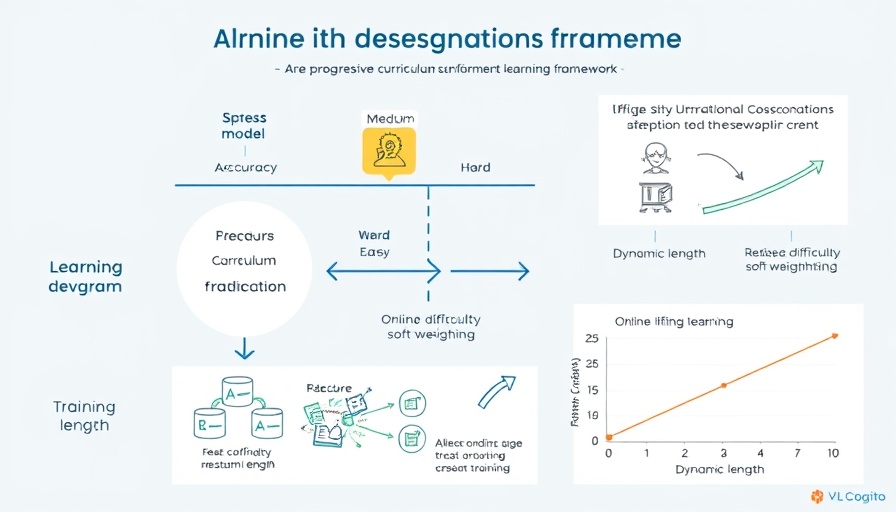
Revolutionizing Small Language Models: Alibaba's New Innovations
In the rapidly evolving world of artificial intelligence (AI), the introduction of Alibaba's Qwen3-4B-Instruct-2507 and Qwen3-4B-Thinking-2507 marks a significant step forward for small language models. Designed with efficiency and versatility in mind, these models promise to enhance the capabilities of small and medium-sized businesses (SMBs) by making advanced AI technology more accessible.
Why Small Language Models Matter
Small language models, like those introduced by Alibaba, prove that size isn't everything. With only 4 billion parameters, these models are built to handle complex tasks efficiently, making them ideal for businesses that require reliable performance without needing extensive computational resources. SMBs often operate under budget constraints, and the affordability and efficiency of these small models help democratize access to powerful AI capabilities.
Understanding the Qwen Models
The Qwen3-4B-Instruct-2507 model, optimized for speed and direct instruction-following, shines in scenarios where clarity is paramount. Unlike traditional models that often generate verbose outputs, this version focuses on providing concise answers, making it especially useful in customer support settings where prompt responses can significantly enhance user experience. Moreover, it boasts multilingual support that allows businesses to cater to a global audience without the language barrier.
On the other hand, the Qwen3-4B-Thinking-2507 emphasizes cognitive reasoning and creative writing, making it suitable for content generation. With capabilities to process lengthy documents or large datasets, it becomes a powerful tool for industries where information accessibility is crucial, such as legal or educational sectors.
Performance Benchmarks: What the Data Shows
The performance benchmarks for these models reveal both their potential and practical applications. For instance, in general knowledge (MMLU-Pro), the Qwen3-4B-Instruct-2507 scored 69.6, indicating a strong grasp of diverse subjects. With a score of 83.5 in creative writing, it showcases its ability to generate engaging content that resonates with users. These benchmarks not only highlight the technical proficiency of the models but also affirm their application in real-world scenarios, reinforcing their value for SMBs.
Actionable Insights for SMBs
For small and medium businesses, embracing these technological advancements can translate into tangible benefits. Here are some actionable insights on how to implement these models effectively:
- Customer Support Automation: Leverage Qwen3-4B-Instruct-2507 to build chatbots that can understand and respond to customer queries across multiple languages, enhancing the customer experience.
- Content Creation: Use Qwen3-4B-Thinking-2507 for generating marketing materials, blogs, and social media content to maintain an engaging brand presence without significant time investment.
- Data Analysis: Harness the model's ability to process extensive datasets. This can streamline your workflows by automating the analysis of legal documents or market research data.
Addressing Concerns: The Role of Smaller Models
Critics might question the effectiveness of smaller language models, wondering if they can truly compete with their larger counterparts. However, by focusing on specific tasks and providing usable context-support, these models create a niche that can cater to varied business needs without draining financial resources. Moreover, as they are optimized for clarity and speed, they refute the misconception that bigger models are always better.
Future Trends: The Path Ahead
As technology continues to advance, the future of AI in small to medium businesses looks promising. The continued development of small language models will likely include enhanced integrations with existing systems, allowing for smoother transitions into these technologies. The potential for collaboration between AI tools and human workers will create opportunities for innovation within the SMB landscape, enabling more efficient operations and improved customer service.
Embracing Change: What Remaining Competitive Means
For small and medium-sized enterprises, staying competitive in today’s marketplace means adapting to change. The innovations seen with Alibaba's Qwen models exemplify the integration of AI into daily operations. Businesses prepared to embrace these changes can expect not only increased efficiency but also the opportunity to connect with their audience in meaningful ways.
In conclusion, the evolution of small language models like Qwen3-4B-Instruct-2507 and Qwen3-4B-Thinking-2507 highlights the importance of efficiency and accessibility in AI technology. By leveraging these tools, SMBs can not only save time and resources but also improve their overall service offerings and communication with customers.
 Add Row
Add Row  Add
Add 



Write A Comment